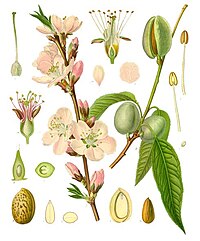
Effect of Prunus dulcis and Salvia hispenica in the management of polycystic ovary syndrome in Wistar rats
Sign Up to like & getrecommendations! Published in 2020 at "Journal of Taibah University Medical Sciences"
DOI: 10.1016/j.jtumed.2020.02.002
Abstract: Objective Research has shown that polycystic ovary syndrome (PCOS) is a common cause of infertility in women. The drugs used to treat PCOS tend to manage the symptoms rather than cure the disease. Furthermore, these… read more here.
Keywords: dulcis; polycystic ovary; hispenica; prunus dulcis ... See more keywords

In-vitro antioxidative potential of different fractions from Prunus dulcis seeds: Vis a vis antiproliferative and antibacterial activities of active compounds
Sign Up to like & getrecommendations! Published in 2017 at "South African Journal of Botany"
DOI: 10.1016/j.sajb.2016.10.013
Abstract: Abstract In the present investigation, antioxidant activities of different fractions of Prunus dulcis seed extract were evaluated. The warring blender method was employed for extraction and total phenol and flavonoid contents were correlated with the… read more here.
Keywords: different fractions; seed; prunus dulcis; fractions prunus ... See more keywords

The impact of non-structural carbohydrates (NSC) concentration on yield in Prunus dulcis, Pistacia vera, and Juglans regia
Sign Up to like & getrecommendations! Published in 2022 at "Scientific Reports"
DOI: 10.1038/s41598-022-08289-8
Abstract: Successful yield in orchards is the culmination of a series of events that start with plants entering dormancy with adequate energy reserves (non-structural carbohydrates; NSC). These NSC are responsible for the maintenance of activities during… read more here.
Keywords: prunus dulcis; yield; carbohydrates nsc; non structural ... See more keywords

Antibacterial activity and chemical characterization of almond (Prunus dulcis L.) peel extract
Sign Up to like & getrecommendations! Published in 2022 at "Natural Product Research"
DOI: 10.1080/14786419.2022.2103556
Abstract: Abstract In this study, almond skin of Prunus dulcis L. variety Casteltermini was characterised for its chemical composition and for the inhibitory activity towards food associated microorganisms belonging to pathogenic (Salmonella Enteritidis, Staphylococcus aureus, Escherichia… read more here.
Keywords: prunus dulcis; almond; dulcis; antibacterial activity ... See more keywords

Pollination Requirements of Almond (Prunus dulcis): Combining Laboratory and Field Experiments
Sign Up to like & getrecommendations! Published in 2018 at "Journal of Economic Entomology"
DOI: 10.1093/jee/toy053
Abstract: Abstract Almond (Prunus dulcis (Mill.) D. A. Webb; Rosales: Rosaceae) is a cash crop with an estimated global value of over seven billion U.S. dollars annually and commercial varieties are highly dependent on insect pollination.Therefore,… read more here.
Keywords: almond prunus; pollination requirements; prunus dulcis; pollination ... See more keywords

Examining physiological, water relations, and hydraulic vulnerability traits to determine anisohydric and isohydric behavior in almond (Prunus dulcis) cultivars: Implications for selecting agronomic cultivars under changing climate
Sign Up to like & getrecommendations! Published in 2022 at "Frontiers in Plant Science"
DOI: 10.3389/fpls.2022.974050
Abstract: The search for drought tolerant species or cultivars is important to address water scarcity caused by climate change in Mediterranean regions. The anisohydric–isohydric behavior concept has been widely used to describe stomatal regulation during drought,… read more here.
Keywords: water; almond; isohydric behavior; anisohydric isohydric ... See more keywords

Synteny-Based Development of CAPS Markers Linked to the Sweet kernel LOCUS, Controlling Amygdalin Accumulation in Almond (Prunus dulcis (Mill.) D.A.Webb)
Sign Up to like & getrecommendations! Published in 2018 at "Genes"
DOI: 10.3390/genes9080385
Abstract: The bitterness and toxicity of wild-type seeds of Prunoideae is due to the cyanogenic glucoside amygdalin. In cultivated almond (Prunus dulcis (Mill.) D.A. Webb), a dominant mutation at the Sk locus prevents amygdalin accumulation and… read more here.
Keywords: prunus; mill webb; almond; prunus dulcis ... See more keywords